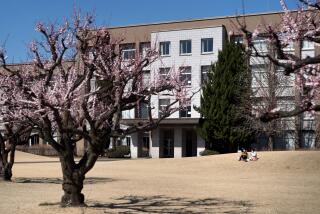VIEWPOINTS : Japan’s Economy Mimicking U.S. : Conditions Like Those Prior to the Depression
- Share via
Today’s economic conditions are very similar to those of the late 1920s that ushered in the Great Depression.
Then, just as now, pervasive surpluses spurred fierce international competition, with many countries resorting to protectionism. International debt problems emerged, and weak prices and outright deflation plagued commodity markets.
In addition, stocks were about as buoyant as they have been in the 1980s. Even the insider trading scandals of the two eras have much in common.
The most striking parallel, however, may be between the economic position of the United States in the late 1920s and that of Japan today. In many ways, Japan is where the United States was 60 years ago, an emerging world economic power experiencing rapid growth amid a stagnant global economy.
This boom, however, has its drawbacks: Even though Japan is well off now, its rapid growth is creating internal imbalances and distortions that may turn its next recession into a disaster similar to that of the United States in the 1930s.
The United States, on the other hand, now is more like Great Britain in the 1920s and 1930s. After losing its world dominance after World War I, Britain suffered from slow growth, industrial overcapacity and high unemployment. Still, Britain did not take as big a fall as the United States during the Depression. So, if history repeats itself, this country’s decline likewise might not be as severe in the next economic downturn.
Now and Then Comparison
Consider the historical similarities: Between the world wars, the United States blossomed into a world economic leader.
U.S. unemployment averaged only 3.7% between 1922 and 1929, and gross national product grew almost 40%. The trade surplus amounted to more than 1% of GNP, and the United States became a net international lender.
Money flowed into U.S. securities; stock prices rose 497% from 1921 to 1929. Meanwhile, the pound was overvalued because Britain went back to the prewar gold standard, and to prevent a capital flight to the United States, the U.S. Federal Reserve artificially held down interest rates. This encouraged stock investment at the expense of bonds and made borrowing to speculate in stocks attractive.
Then things came unglued. The Dow fell 89% between 1929 and 1932; the consumer price index declined 24% between 1929 and 1933, and GNP was off 22%. The ratio of the value of stocks on the New York Stock Exchange to GNP was cut in half between 1929 and 1931, to 35% from 70%.
In Britain, where speculation had been considerably less rampant and the market rise during the 1920s was only one-sixth of Wall Street’s, the crash was not as severe.
Now America is the waning economic power and the waxing one is Japan. The United States has long been the high-cost producer in many industries, but this fact remained hidden during the shortages of the 1970s. Then the world took a turn to surpluses and competition intensified. The desire to consume and the inability to compete led to huge U.S. trade deficits that by 1986 reached 3.5% of GNP.
To finance our trade gap, we had to borrow, last year becoming a net international debtor for the first time since World War I. Unemployment remains above 6% despite 4 1/2 years of expansion and fiscal stimulus requiring annual budget deficits that have exceeded $200 billion.
Reluctant Leader
Like the isolationist United States between the two world wars, Japan appears reluctant to accept the role of a dominant economic power. But even in a world of excess supply, Japan has amassed a phenomenal $100-billion trade surplus in the fiscal year ended March 31, up from $53 billion a year before.
The Japanese stock market has been extremely bullish. In a decade, Tokyo’s share of world stock market trading has risen to 36% from 14%, while Wall Street’s has fallen to 36% from 61%. Just as the United States held down its interest rates to support the pound in the 1920s, Japan now is keeping interest rates low to support the dollar, encouraging investment in that nation’s stocks.
The environment is ideal for 1920s-style speculation, which has been rampant. The ratio of stock market value to GNP in Japan is 130%, compared to 60% in the United States. Nippon Telegraph & Telephone, for example, has a price-to-earnings ratio of more than 250 and a market value exceeding that of the entire West German stock market.
Signs of trouble for the Japanese economy have surfaced, however. In the years following World War II, Japan was able to develop rapidly by imitating and adapting Western technology and becoming a low-cost producer of an increasingly sophisticated array of exports. But now the newly industrialized countries are following its footsteps.
Their success has been enviable: In 1970, Korea, Taiwan, Hong Kong, Singapore, Brazil and Mexico accounted for just 4% of global exports; today they account for 10%, more than Japan does.
Thus far, Japan has been able to find even more sophisticated goods to stay ahead of the newly industrialized countries and maintain its export-led growth. Whether it can continue to do so isn’t clear.
Moreover, the strong yen and protectionism are forcing many Japanese firms to produce abroad--in the newly industrialized countries, Europe and North America. By the year 2000, Japan’s largest manufacturing firms are expected to produce some 20% of their output abroad, compared to 3.4% in 1982.
Unemployment already has hit the postwar high of 3%. If the “hidden jobless”--those who would be out of jobs if they didn’t have guaranteed lifetime employment--are taken into account, the rate certainly would be much higher. How long can these surplus workers be assigned to trim the hedge around the factory building?
The next recession, therefore, may bring the Japanese economy down with a crash that will be spearheaded by the same sort of overheated stock market the United States experienced before the Great Depression. In the United States this time, the recession will be considerably milder, not because we are in an intrinsically stronger position, but because our recent economic gains have been far smaller than Japan’s, and the speculation in our markets has been far less rabid.
More to Read
Inside the business of entertainment
The Wide Shot brings you news, analysis and insights on everything from streaming wars to production — and what it all means for the future.
You may occasionally receive promotional content from the Los Angeles Times.










